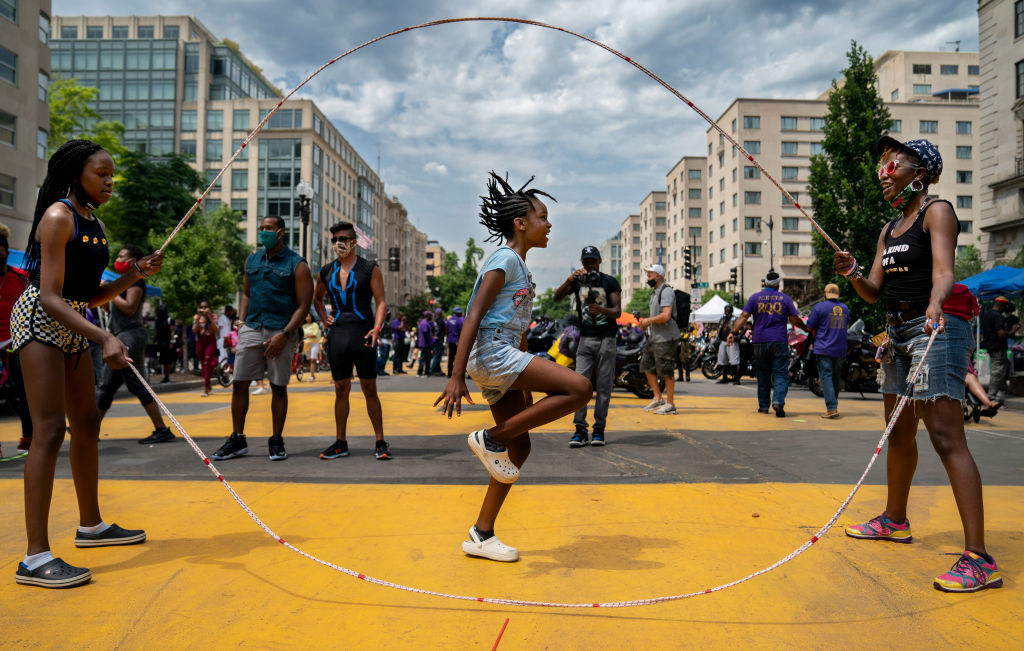
Double dutch jump roping is shown during D.C.’s Chocolate City Experience around Black Lives Matter Plaza on June 27, 2020. | Source: The Washington Post / Getty
There are now fewer white people who call the nation’s capital home than there were before the pandemic in a demographic shift that is helping to restore the “Chocolate City” nickname that had increasingly become a misnomer in recent years.
During 12 months in the middle of the COVID-19 pandemic, more than 10,000 non-Hispanic white people fled Washington, D.C., according to the Washington Post, which cited newly released Census data. Those findings show a serious reversal of white people moving to the city that is part of a larger heated debate about the effects that gentrification has had on the District of Columbia’s Black population.
MORE: The Fight For D.C. Statehood Is A 21st Century Civil Rights Issue
“In the four years preceding the pandemic, the city had been adding non-Hispanic White residents at a rate of around 4,000 to 5,000 each year,” the Post reported. “But between July 2020 and July 2021, it lost 10,285 people from that group, according to the bureau’s annual population estimates for the nation, states and counties by age, sex, race and Hispanic origin.”
The apparent so-called “white flight” — the phenomenon of white people fleeing urban areas in droves — was consistent with trends in other major cities ravaged by the coronavirus.
Those numbers may not be reflected on the official Census Bureau page for Washington, D.C., which shows the city has a Black population of 45.8% compared to a white population of 45.9%.
While that margin is as slim as can be, the number of white people eclipsing Black people in a city renowned for its Black population has prompted a number of questions.
Back in the 1980s, as much as 70% of the city’s population was estimated to be Black people. Decades later, that majority was threatened before finally being eclipsed by white residents in 2015.
The number of white people living in D.C. had been steadily increasing until the Census Bureau released its new findings Thursday.
A glaring example of the surge of white people living in Black D.C. neighborhoods came in 2019 when Howard University students and community residents attended an Advisory Neighborhood Commission meeting to voice concerns with white, local residents using the historically Black college campus to walk their dogs.
And separately nearby, new residents living in a luxury apartment building complained about a decades-long tradition of a store on the corner of Florida Avenue and 7th Street in the Shaw neighborhood playing go-go music from speakers outside the business.
A 2017 study published by Georgetown University analyzing the impact of the district’s booming economy on Black residents painted a picture of profound economic disparities between the city’s Black and white residents. The average net worth of a white household was $284,000 compared to just $3,500 for Black households.
There was also a huge gap in median annual incomes: Whites with $120,000 and Blacks with $41,000.
The disproportionate number of new jobs in D.C. requiring at least a bachelor’s degree stood in stark contrast with the 12% of Black D.C. residents being college graduates as of 2014, the study noted.
Consequently, White residents were able to pay more for housing, which has driven up costs and reduced available affordable housing.
Those types of inequalities stem from a history of discrimination that pushed the District’s Black residents to the fringes of the economy, the study said. Historic discriminatory practices have ranged from segregated schools to redlining, a racist practice in which banks refused to lend money to Black entrepreneurs and home buyers.
SEE ALSO:
‘New Soul Of Harlem’: Restaurant Ad Showing Only White Patrons Sparks Outrage, Briefly
Gentrification In Detroit: Non-Black Residents Sue For Housing Discrimination

